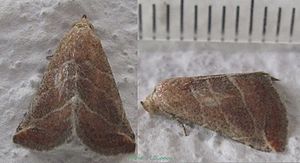Eublemma facts for kids
Quick facts for kids Eublemma |
|
|---|---|
 |
|
| Scientific classification |
|
| Kingdom: | Animalia |
| Phylum: | Arthropoda |
| Class: | Insecta |
| Order: | Lepidoptera |
| Superfamily: | Noctuoidea |
| Family: | Erebidae |
| Subfamily: | Boletobiinae |
| Genus: | Eublemma Hübner, 1829 |
| Synonyms | |
|
|
Eublemma is a group of small moths. They belong to a large moth family called Erebidae. A scientist named Jacob Hübner first described them in 1829. These moths are found in many parts of the world.
Contents
Understanding Eublemma Moths
What is a Genus?
A genus is a way to group living things that are very similar. Think of it like a family name for different species. All moths in the Eublemma genus share many common features.
How Scientists Classify Eublemma
Scientists use a system called taxonomy to organize living things. This helps them understand how different species are related. The Eublemma moths have been placed in different groups over time.
- They are currently in the Erebidae family, under a smaller group called Eublemminae.
- Before, some scientists thought they belonged to the Noctuidae family, in a group called Eustrotiinae.
- This shows how science learns more over time.
Physical Features of Eublemma Moths
Eublemma moths have some special body parts. These features help scientists identify them.
- Palpi: These are like small feelers near the moth's mouth. They point upwards and reach just above the head. They have a short third part.
- Antennae: In male moths, the antennae have tiny hairs. These hairs are called cilia.
- Body: The main body parts, the thorax (chest) and abdomen (belly), are covered in smooth scales.
- Legs: Their legs are short. The tibia (a part of the leg) has a moderate amount of hair.
- Forewings: The front wings have a slightly pointed and lowered tip.
- Wing Veins: The veins on the wings follow a specific pattern. For example, veins 6 and 7 start from the cell's angle. Veins 8 to 10 branch out from before the cell's angle.
- Hindwings: The back wings also have specific vein patterns. Veins 3, 4, 6, and 7 come from the angles of the cell.
- Larva: The young moths, called larvae or caterpillars, have two pairs of prolegs. These are fleshy, stubby legs on their abdomen that help them grip surfaces.
Many Types of Eublemma Moths
There are many different kinds of Eublemma moths. Each kind is called a species. They are found all over the world, from Africa to Australia and Asia. Here are just a few examples:
- Eublemma accedens is found in places like Burkina Faso, Australia, and Fiji.
- Eublemma amabilis lives in Sri Lanka.
- Eublemma amoena can be seen in northern Africa and southern Europe.
- Eublemma cochylioides is found in Europe, Africa, Asia, and Australia.
- Eublemma parva is a small marbled moth found in many regions, including Africa, Europe, and Australia.
- Eublemma purpurina is a purple marbled moth found across Europe and Asia.
These moths show how diverse the insect world is!
See also
 In Spanish: Eublemma para niños
In Spanish: Eublemma para niños

